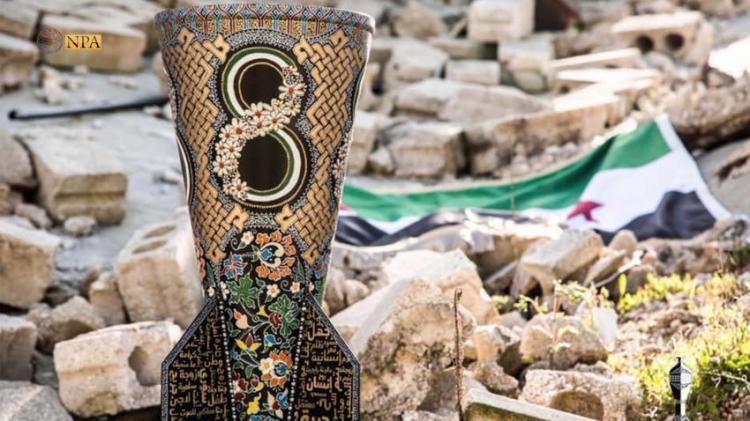Al-Bab – North-Press Agency
Muhammad al-Yanayri
“I am the Syrian who never weakens”, with these words, the Syrian artist Akram Suweidan presents himself on his personal page on Facebook, before they dive into his own world, where ugliness turns into beauty and death into a vibrant natural colors with unique artistic touches that do not falsify reality, rather, it coexists with it in a different way, giving a hint of beauty to a reality wrapped in destruction and death.
“The Ramadan cannon is made of a 23 mm bullet casings and wonderful paints are made of a 14.5 mm empty shell,” is a part of Sweidan’s artistic creation, in which he transforms remnants of empty casings and shells of war into artworks using colors. “I will put the diamonds on the top of the war machines that killed humans and humanity. Perhaps one day the sun of freedom will shine on them, it may lighten, so the world shall see the greatness of these people”.
Suweidan was born in 1979 in the city of Duma in the countryside of Damascus, he now lives in the city of Al-Bab in the northeastern countryside of Aleppo, after being displaced last April in 2018. He was famous for his artworks and a project which he called “Drawing on Death”.

Drawing on death
Suweidan launched his “Drawing on Death” project after he was released from prison in 2012, he insisted on expressing how peaceful the Syrian people are, through art, as he told to North-Press: “I transformed the weapons that kill us into an artistic shapes, I try to draw a smile and spread beauty, in an attempt to reflect the peaceful side of the Syrian people.” Thus, giving a glimmer of hope and life in a reality filled with despair and ugliness.
He started his project by collecting the remnants of war as empty bullets and shells, and then began drawing on them, until he became famous, where he participated with his works in exhibitions since 2015 outside Syria which he couldn’t be present there, due to the difficulty of traveling, but he succeeded in documenting a part of the Syrian creativity, in a different way than the images of killing, destruction, displacement and death that overwhelm the Syrian scene and stick in mind whenever Syria is mentioned in the wartime.
Suweidan’s works have reached Qatar, the United States and the European countries such as Belgium, France, Germany, and Sweden through some exhibitions celebrating his creative work, “the remnants of the shells, which children were afraid of, became pieces of art to be celebrated with,” he said.
After leaving Ghouta in eastern Damascus in 2018, Akram’s works, as usual, were marked with hope, he used remnants of a Russian MIG plane and completed its design with a graphic: “We’ll return” written on it, and wrote a number of areas’ names from which its people were displaced.
Overseas Exhibitions
As his work surpassed Syria’s borders, Akram was about to take part in one of the most popular programs: “Arab Got Talent” in 2016, after the team of the program contacted him and welcomed his participation, but the siege which was imposed on al-Ghouta by the Syrian government Forces prevented him from traveling outside of Syria and to participate in the program and deliver his message of peace, love, and beauty, just like he was prevented from participating in art exhibitions showing his work in Europe, US, and some Arab countries.

“Art is a great message of all times, let alone wartimes, as it means so much,” Akram said, “We all know that paper is made for writing and wood for decorating, etc. But in times of war, all substances are made for art works, because art has a goal and must reach to the largest section, I draw on the remnants of war and missiles, conveying a message of peace and other messages, including the love of life”.

Akram Suweidan is among many of whom resist the ugliness of war by the beauty and creativity of art, like other Syrian artists at all levels of art and creativity, whether painters, sculptors, players, artists, singers, actors, directors, writers, and others. Some of them were rewarded with great prizes in recognition of their creativity, under the slogan of “The sun of the Syrian creativity did not and will not set”.

